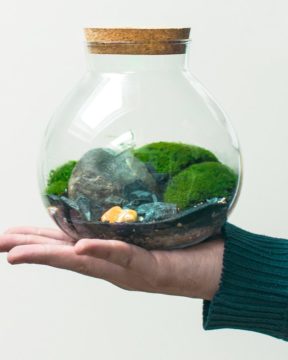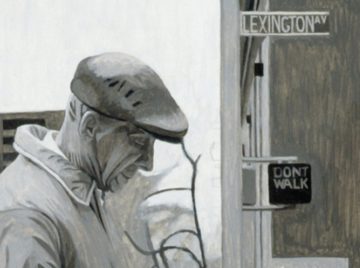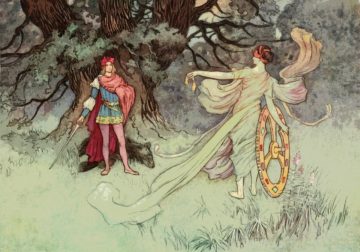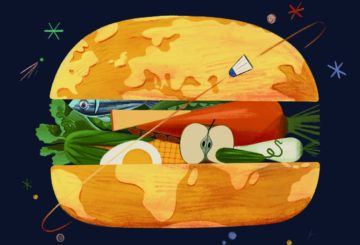Month: December 2021
White Gods
Anna Della Subin in The Paris Review:
 “We were superior to the god who had created us,” Adam recalled not long before he died, age seven hundred. According to The Apocalypse of Adam, a Coptic text from the late first century CE, discovered in Upper Egypt in 1945, Adam told his son Seth that he and Eve had moved as a single magnificent being: “I went about with her in glory.” The fall was a plunge from unity into human difference. “God angrily divided us,” Adam recounted. “And after that we grew dim in our minds…” Paradise was a lost sense of self, and it was also a place that would appear on maps, wistfully imagined by generations of Adam’s descendants. In the fifteenth century, European charts located Eden to the east, where the sun rises—an island ringed by a wall of fire. With the coordinates in their minds, Europe’s explorers could envisage a return to wholeness, to transcendence, to the godhood that had once belonged to man.
“We were superior to the god who had created us,” Adam recalled not long before he died, age seven hundred. According to The Apocalypse of Adam, a Coptic text from the late first century CE, discovered in Upper Egypt in 1945, Adam told his son Seth that he and Eve had moved as a single magnificent being: “I went about with her in glory.” The fall was a plunge from unity into human difference. “God angrily divided us,” Adam recounted. “And after that we grew dim in our minds…” Paradise was a lost sense of self, and it was also a place that would appear on maps, wistfully imagined by generations of Adam’s descendants. In the fifteenth century, European charts located Eden to the east, where the sun rises—an island ringed by a wall of fire. With the coordinates in their minds, Europe’s explorers could envisage a return to wholeness, to transcendence, to the godhood that had once belonged to man.
Every time he stepped off the ship’s rowboat and onto the soft sand, exploring places later known as Cuba, Haiti, and the Bahamas, Columbus seemed to walk on the clouds. On December 13, he wrote that a chieftain had informed a crowd of two thousand fearful, trembling kinsmen that “the Christians were from heaven.” The people put their hands on their heads, in “a sign of great reverence,” and made offerings of yams and fish. Approached by an envoy of hundreds of islanders several days later, Columbus again recorded their belief in his celestial status, although he noted that the chief and his advisers “were very sorry that they could not understand me, nor I them. However,” he continued, “I knew that they said that, if I wanted anything, the whole island was at my disposal.” Conquest followed apotheosis: every island he found, filled with people allegedly mistaking him for divine, the mariner took possession of for Spain. He would read an indecipherable declaration, then pause for a refusal that could not occur. “No opposition was offered to me,” Columbus wrote.
More here.
The magical miniature worlds of terrariums
Franco and Robson in BBC:
 The roots of the modern terrarium can be traced to a 19th Century experiment by Nathaniel Bagshaw Ward, an English doctor who also studied botany and entomology. Ward’s interest seems to have arisen from a journey to Jamaica as a 13-year-old boy, when he fell in love with the exotic plant life. Growing up, he developed a large collection of specimens, but he was disappointed to find that many species – particularly the ferns and mosses – failed to thrive in his east London garden, thanks, in large part, to the air pollution of the city. The UK was, after all, in the midst of the Industrial Revolution, meaning that his house was “surrounded by, and enveloped in, the smoke of numerous manufacturies”, which brought coal, ash and other toxic chemicals into contact with his precious plants.
The roots of the modern terrarium can be traced to a 19th Century experiment by Nathaniel Bagshaw Ward, an English doctor who also studied botany and entomology. Ward’s interest seems to have arisen from a journey to Jamaica as a 13-year-old boy, when he fell in love with the exotic plant life. Growing up, he developed a large collection of specimens, but he was disappointed to find that many species – particularly the ferns and mosses – failed to thrive in his east London garden, thanks, in large part, to the air pollution of the city. The UK was, after all, in the midst of the Industrial Revolution, meaning that his house was “surrounded by, and enveloped in, the smoke of numerous manufacturies”, which brought coal, ash and other toxic chemicals into contact with his precious plants.
The solution came in 1829 from one of Ward’s entomological experiments. He had been trying to hatch the chrysalis of a sphinx moth, buried in some moist mould within a covered bottle. The water, he noticed, would evaporate and then condense on the side, before returning to the mould – seemingly recreating the basic flow of the Earth’s weather systems. After a few days, Ward was surprised to find a tiny fern had begun to grow in the sealed ecosystem.
More here.
Thursday Poem
On David Attenborough’s Possibility of Grief without Anthropomorphising
The problem for the scriptwriter is being human, desperately seeking proof in the lay of a trunk, the nudge of a mother’s foot against her child’s cracked hide lying in the dust and drought, flies swirling helixes in the air. What should we make of her refusal to move, the others who keep moving toward the horizon’s dull shimmer? The stretch of an elephant’s foot contains muscles capable of interpreting vibrations through the ground. How do we measure the frequencies of our loss? A raised leg, a pointed toe, the nudge of a mother’s foot. Even though you have been gone for two years, my mind continues to stumble over your body, the quick pause of surprise, my mother’s stubborn refusal to leave your side, the lack of sound where your breath should be. When they find bones whose bleach they recognize as their own, a herd will stand in a circle together, faces gray, vibrating low moaning syllables as the sun and shadow, like a rib cage, expand.
by Jared Beloff
from Contrary Magazine
Going Down On Wendell Berry
Lulu Miller at The Paris Review:

Out of boredom, you tug a little on the navy wool of Wendell Berry’s sweater, undoing the cocoon in which you realize your thumb has begun to hope to turn into something new. He shudders a little at the ripple of cold air against his abdomen. Your thumb is saying: No, let us not go any further. Let us not do what we are programmed to do, how society and evolution have wired us to reap our worth. Let us instead stay here forever, above the waistband. Let us incubate in the warmth of Wendell Berry’s agricultural exertion. Let us listen to the roiling music of digestion. Let us crane to hear the music of the dirt—over half of Earth’s biodiversity clanging and gnawing and joining filaments beneath our feet, showing us another way to flourish, prospering by mending. Let us forget, temporarily, about the world beyond this farm, where roads are wet with oil slicks, clouds are pricked with jets, and flesh too easily torn open by lead traveling faster than the speed of sound. Let us believe we can go back to a time when man did not yet know about the stockpile of sunshine waiting beneath the soil—sunshine stolen by plants and condensed by time into a black reduction that can equip our every last fear. Let us believe the way back is through restraint: treading water by fingering dirt.
more here.
Wendell Berry: The Thought of Limits in the Prodigal Age
The Remarkable Life of Virgil Abloh
Doreen St. Félix at The New Yorker:
 For the polymath, there is always a cardinal subject, a chief preoccupation around which all the other interests spin. For the fashion designer Virgil Abloh, the polymath of his cohort, who died on Sunday of a rare cardiac cancer, offensively too young, the center was architecture. He studied as an architect, and the training never really left him, even as he ventured into other arts. Abloh’s thinking was organizational, spatial, and mind-numbingly lofty. He longed to build an intricately structured life for his muse, the young Black man. Abloh designed not only this man’s clothing but also his shoes, the music he listened to in order to prime himself for the workday, the furniture he looked upon before leaving for said workday, the shiny vernacular he used in his speech, the high-concept museum exhibition at which he could practice this speech. At forty-one years old, Abloh already did all that, and so the question coursing through the minds of his mourners, whose lives had been quite literally stamped with the fruits of his imagination, is this: What was next?
For the polymath, there is always a cardinal subject, a chief preoccupation around which all the other interests spin. For the fashion designer Virgil Abloh, the polymath of his cohort, who died on Sunday of a rare cardiac cancer, offensively too young, the center was architecture. He studied as an architect, and the training never really left him, even as he ventured into other arts. Abloh’s thinking was organizational, spatial, and mind-numbingly lofty. He longed to build an intricately structured life for his muse, the young Black man. Abloh designed not only this man’s clothing but also his shoes, the music he listened to in order to prime himself for the workday, the furniture he looked upon before leaving for said workday, the shiny vernacular he used in his speech, the high-concept museum exhibition at which he could practice this speech. At forty-one years old, Abloh already did all that, and so the question coursing through the minds of his mourners, whose lives had been quite literally stamped with the fruits of his imagination, is this: What was next?
more here.
My Identity Problem
Alan Shapiro in The Hedgehog Review:
 If childhoods have leitmotifs, mine was the steady, subtle, though sometimes bullying insistence on the unsurpassed importance of my Jewish American identity. On one side of my two-track upbringing, there was the uncontested conviction that Jews were the chosen people, the main players in God’s plan for humanity; on the other side, the daily pledge of allegiance to the American Republic, in all its shining-city- on-a-hill exceptionalism. How it is that my self-importance is not positively Trumpian is as big a mystery as why Muammar al-Qaddafi took over Libya and declared himself colonel, not king, or why, as John Berryman once wondered, cats love fish and hate water.
If childhoods have leitmotifs, mine was the steady, subtle, though sometimes bullying insistence on the unsurpassed importance of my Jewish American identity. On one side of my two-track upbringing, there was the uncontested conviction that Jews were the chosen people, the main players in God’s plan for humanity; on the other side, the daily pledge of allegiance to the American Republic, in all its shining-city- on-a-hill exceptionalism. How it is that my self-importance is not positively Trumpian is as big a mystery as why Muammar al-Qaddafi took over Libya and declared himself colonel, not king, or why, as John Berryman once wondered, cats love fish and hate water.
Unfortunately, and for reasons I don’t completely understand, my emotional investment in these and other inherited identities didn’t extend much beyond my immediate family, which was anything but coherent or harmonious.
More here.
The Climate Movement’s Secret Weapon
Daniel A. Hanley at Noema:
 In the face of escalating extreme weather events, monopolistic corporations that profit from activities that accelerate climate change have consistently blocked U.S. politicians’ attempts to avert disaster. In some cases, they fund think tanks that publish anti-climate propaganda. In other cases, they spend millions on lobbying politicians. State legislatures provide no sanctuary either, with big oil and gas companies providing funds to political campaigns and lobbying. In other cases, companies like Monsanto and Koch Industries directly fund lawsuits to protect their private interests. No opportunity to thwart progress seems to be wasted.
In the face of escalating extreme weather events, monopolistic corporations that profit from activities that accelerate climate change have consistently blocked U.S. politicians’ attempts to avert disaster. In some cases, they fund think tanks that publish anti-climate propaganda. In other cases, they spend millions on lobbying politicians. State legislatures provide no sanctuary either, with big oil and gas companies providing funds to political campaigns and lobbying. In other cases, companies like Monsanto and Koch Industries directly fund lawsuits to protect their private interests. No opportunity to thwart progress seems to be wasted.
Even corporations with purported climate goals are, overall, apathetic about encouraging lawmakers to enact comprehensive solutions. They often resist changing their operations, and over 90% of corporate sustainability pledges fail.
More here.
The Universal Structure of Storytelling
Jonathan Gottschall in Quillette:
 In the mid-2000s I set out, along with my colleagues Joseph Carroll, John Johnson, and Dan Kruger, on a large-scale study of classic Victorian novels by such authors as Jane Austen, George Eliot, and Charles Dickens, among many others. We distributed a survey to hundreds of knowledgeable people—professors, graduate students taking courses on Victorian literature, and authors who had published articles or books in the field. The respondents rated the attributes of characters in the novels exactly as if these fictional people were actual people.
In the mid-2000s I set out, along with my colleagues Joseph Carroll, John Johnson, and Dan Kruger, on a large-scale study of classic Victorian novels by such authors as Jane Austen, George Eliot, and Charles Dickens, among many others. We distributed a survey to hundreds of knowledgeable people—professors, graduate students taking courses on Victorian literature, and authors who had published articles or books in the field. The respondents rated the attributes of characters in the novels exactly as if these fictional people were actual people.
We wrote up the results in our book, Graphing Jane Austen: The Evolutionary Basis of Literary Meaning. The main finding had to do with something we called agonistic structure, which we took to be a fundamental structural element of storytelling in much the same way that roofs are fundamental to houses. For all the variety in these novels, for all the differences in personality and gender and background of authors stretching over a century, they made strikingly similar choices regarding characterization. As a whole, Victorian novels reflect a sharply polarized fictional universe of good people (the protagonists and their allies) and bad people (the antagonists and their allies) locked in conflict. Overwhelmingly, protagonists looked to cooperate and work toward the common good while antagonists sought to dominate for selfish ends.
More here.
Elizabeth Popp Berman ─ Thinking Like an Economist
Ethical AI Matches Human Judgements in 90 per cent of Moral Dilemmas
From Discover Magazine:
 The ethical rules that govern our behavior have evolved over thousands of years, perhaps millions. They are a complex tangle of ideas that differ from one society to another and sometimes even within societies. It’s no surprise that the resulting moral landscape is sometimes hard to navigate, even for humans. The challenge for machines is even greater now that artificial intelligence now faces some of the same moral dilemmas that tax humans. AI is now being charged with tasks ranging from assessing loan applications to controlling lethal weapons. Training these machines to make good decisions is not just important, it is a matter of life and death for some people. And that raises the question of how to teach machines to behave ethically.
The ethical rules that govern our behavior have evolved over thousands of years, perhaps millions. They are a complex tangle of ideas that differ from one society to another and sometimes even within societies. It’s no surprise that the resulting moral landscape is sometimes hard to navigate, even for humans. The challenge for machines is even greater now that artificial intelligence now faces some of the same moral dilemmas that tax humans. AI is now being charged with tasks ranging from assessing loan applications to controlling lethal weapons. Training these machines to make good decisions is not just important, it is a matter of life and death for some people. And that raises the question of how to teach machines to behave ethically.
Today we get an answer of sorts thanks to the work of Liwei Jiang and colleagues at the Allen Institute of Artificial Intelligence and the University of Washington, both in Seattle. This team has created a comprehensive database of moral dilemmas along with crowdsourced answers and then used it to train a deep learning algorithm to answer questions of morality.
The resulting machine called DELPHI is remarkably virtuous, solving the dilemmas in the same way as a human in over 90 per cent of the cases. “Our prototype model, Delphi, demonstrates strong promise of language-based common sense moral reasoning,” say Jiang and co. The work raises the possibility that future AI systems could all be pre-trained with human values in the same way as they are pre-trained with natural language skills. The team begin by compiling a database of ethical judgements from a wide range of real-world situations. They take these from sources such as the “Am I the Asshole” subreddit, a newspaper agony aunt called Dear Abby, from a corpus of morally informed narratives called Moral Stories and so on. In each case, the researchers condense the moral issue at the heart of the example to a simple statement along with a judgement of its moral acceptability. One example they give is that “helping a friend” is generally good while “helping a friend spread fake news” is not. In this way, they build up 1.7 million examples they can use to train an AI system to tell the difference.
More here.
What humanity should eat to stay healthy and save the planet
Gayathri Vaidyanathan in Nature:
 A clutch of fishing villages dot the coast near Kilifi, north of Mombasa in Kenya. The waters are home to parrot fish, octopus and other edible species. But despite living on the shores, the children in the villages rarely eat seafood. Their staple meal is ugali, maize (corn) flour mixed with water, and most of their nutrition comes from plants. Almost half the kids here have stunted growth — twice the national rate. In 2020, Lora Iannotti, a public-health researcher at Washington University in St. Louis, and her Kenyan colleagues asked people in the villages why the children weren’t eating seafood, even though all the parents fish for a living; studies show that fish and other animal-source foods can improve growth1. The parents said it made more financial sense for them to sell their catch than to eat it.
A clutch of fishing villages dot the coast near Kilifi, north of Mombasa in Kenya. The waters are home to parrot fish, octopus and other edible species. But despite living on the shores, the children in the villages rarely eat seafood. Their staple meal is ugali, maize (corn) flour mixed with water, and most of their nutrition comes from plants. Almost half the kids here have stunted growth — twice the national rate. In 2020, Lora Iannotti, a public-health researcher at Washington University in St. Louis, and her Kenyan colleagues asked people in the villages why the children weren’t eating seafood, even though all the parents fish for a living; studies show that fish and other animal-source foods can improve growth1. The parents said it made more financial sense for them to sell their catch than to eat it.
So, Iannotti and her team are running a controlled experiment. They have given fishers modified traps that have small openings that allow young fish to escape. This should improve spawning and the health of the overfished ocean and reef areas over time, and eventually increase incomes, Iannotti says. Then, for half the families, community health workers are using home visits, cooking demonstrations and messaging to encourage parents to feed their children more fish, especially plentiful and fast-growing local species such as ‘tafi’, or white spotted rabbitfish (Siganus canaliculatus) and octopus. The scientists will track whether children from these families eat better and are growing taller than ones who don’t receive the messaging.
The aim of the experiment, says Iannotti, is to understand “which sea foods can we choose that are healthy for the ecosystem as well as healthy in the diet”. The proposed diet should also be culturally acceptable and affordable, she says.
More here.
Wednesday Poem
Overlooked Heroine, Landscape with the Fall of Icarus*
Bruegel chose the moment when young legs
closed like a pocket knife into the waiting sea.
Later, someone called it a mundane disaster;
said, “it couldn’t have been helped,” the flash
of a diving bird that turned out to be a boy.
I say this: Whatever suffering there was,
you brought it to the scene yourself.
You chose to be the shepherd who watched clouds
while a hawk studied sheep from the tree.
You chose to be the sleeping sailor, heavy
in the crow’s nest of that harbor ship,
or the fisherman too busy with his worms.
You must have known by heart the plodding path
walked by a horse wearing leather blinders.
And the ploughman, how did he greet tragedy?
Why, he had laid down his dagger and moneybelt
in the shade, and would not leave them unwatched.
He was no hero, he ploughed without swerving
and let one foot step soft into the turned furrow.
And there, in the field already ploughed,
was a spot on the ground, a pale mound
which proved upon closer inspection
to be the white skull of an old man, settling.
If he noticed either sinking body
the ploughman merely shrugged:
the Dutch have a proverb: De ploeg gaat over lijken
—the plow passes over corpses.
He’d become accustomed to such mounds,
the hard sound leg bones make.
He’d merely lift the blade a bit, and urge
the horse with his whip, “push on.”
I knew his whip, and something of suffering.
I was the ploughman’s daughter Bruegel failed to notice.
I dried my little dress on a branch after the quiet rescue.
by Kathleen Heideman
from decomP Literary Magazine
* After Pieter Bruegel’s painting Landscape with the Fall of Icarus, 1558.

